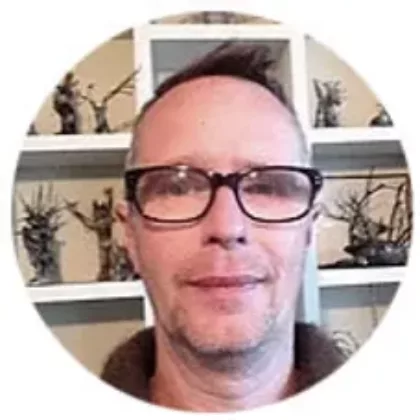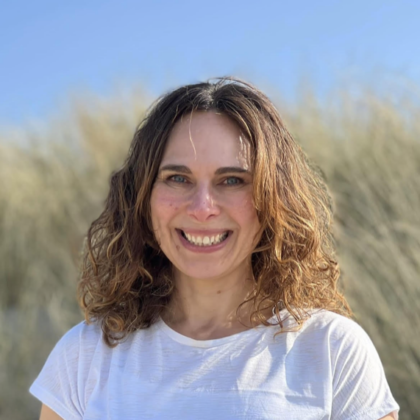Art therapy and stories in prisons
Conversations
Conversations is our regular series dedicated to matching trainees and new practitioners with art therapists who would like to be part of a conversation to discover interesting things about each other and our profession.
In this conversation, new practitioner art therapist, Fléur Davey, speaks with Tony Gammidge. Tony is an art therapist, artist, film maker and animator who has worked in the NHS in both mental health and forensic settings, and with Art Refuge.
This is an edited version of their conversation
You have a particular interest in stories and the use of narrative work as a therapeutic tool. Could you tell me how you found yourself in this field of storytelling?
Fléur
Tony: Yes, it’s an important question. Obviously, it’s a big, big question and there’s no one thing.
Certain films that I made with people made me think ‘Oh, wow! Working with stories is really powerful’, and then, in a way, I had an epiphany at a certain point: I thought ‘Oh, yeah, this is what I’m interested in’, not just in terms of this work with prisoners, or with asylum seekers, but in terms of my own work as well. I think working with people in a secure setting very much inspired me to tell my own story.
I remember hearing an interview with Kirsty Young, who did Desert Island Discs, and she was asked, “Is there anyone you’ve interviewed that you haven’t liked?”. And she said, “when someone tells you their story, it’s hard not to like them”. That really struck me. So there’s something about the humanity of stories. It cuts through a lot of prejudices.
In terms of films I’ve made, I did a project on a low, secure unit – the second animation project I’ve ever done – and a man from Somalia told his story about being a boy soldier. He’d never told that story before. I was really struck with the power of that. Everyone I have worked with ever since has taught me more about that kind of power, of having the storytelling as a lens.
When we think of individuals in prisons and secure units, you have noted that everyone’s story is encapsulated within their case notes and that films can become an alternative to these case notes. Could you expand on what this looks like?
Fléur
Tony: Yes, in prisons, it’s not just in the notes, it’s in their court reports – what went wrong and what they did wrong. Human rights lawyer Bryan Stevenson talks about how we shouldn’t judge people on the worst thing that they’ve done, but that’s what these narratives do.
So, when I first started doing this work, I had no idea. I went into it quite blind. It was more of a felt sense of things and I didn’t know people would use their own stories. I kind of hoped they would, but I never wanted to encourage people to do that. But if people choose to tell their story, or a version of it, sometimes they’ll tell it just as it is, then I might say, ‘Well, do you want to change bits of it?’ So, offer them an alternative.
And also, it’s not just telling, it’s making their story with their hands. So, as we know, trauma is embodied. It’s not just something that happens psychologically, it’s a felt sense, and it’s held within our bodies. So, there’s a lot of people making their story, which is not just about telling it like they would in an assessment or in a court with their lawyer. You know, it’s so different.
I did a project in Sussex in a secure unit, and they started to put people’s artworks and other things – poems and stuff – in their case notes as a way of building that up. So, it’s an alternative.
Fléur: I think what you said about using that work as a way for other professionals to see that too, that’s really helpful and really interesting.
Tony: Exactly. And I think other professionals will say, “Oh, wow, I didn’t know that about that person. I didn’t know that person had it in them”. Or they didn’t know they had a sense of humour. Or they didn’t know that the guy from Somalia was a boy soldier. He’d been in the system for years, and you know they had no understanding of his trauma. Offering people a story making tool is very powerful.
Fléur: It makes total sense, because we all have a story, we’re all responding, aren’t we, to our environment at any given time. There’s a narrative there from the day we’re born, all the kinds of experiences that we have. Perhaps we haven’t really thought in that way, that the collection of all of our experiences, is our story.
I think that, particularly for prisoners in their settings, they’ve had so many different experiences, and they’ve responded to all of those throughout their life at the time. And perhaps that’s one of the reasons why they found themselves in prison; because of their story. It’s so easy to be able to be focused on a certain behaviour at any given time without that understanding. I think, for me, that’s been such a privilege, to be able to hear these stories.
Do you see your role as wholly therapeutic or is there another aspect of the work, for instance a social angle that the work can take?
Tony
Fléur: It does kind of come back to those individual stories because they build on a collective of all of the people within that setting. They all have a story, and I think it’s about that understanding.
Because I work with children and young people with developmental trauma in the here and now, and then having worked with adults who have been through that journey, I get to see how those really challenging, difficult experiences can manifest into responsive behaviour. What I’ve noticed when I’ve worked with prisoners, the work has been quite reparative, because you’re working with those parts, those aspects that have been missed. And I think it’s that work which can be seen in the visual form, whether it’s through different types of art therapy and creative therapies is something to be really aware of in how we actually relate to our children and young people now, because they’re going to grow up to become young adults. If they are still travelling through their journey with unprocessed experiences, or perhaps met with unrelational kinds of experiences, then we’re almost setting some of our young people up to fail.
I think that’s the kind of social aspect for me. Really having an understanding, as a culture and how we think as a society, of how we work with children and young people, particularly those that have challenging times, and how we support them.
Tony: I was just thinking about how that would be to tell people you work within a prison, how working with them kind of inspires and informs your work with children. I wonder what impact that would have on them? Almost everyone I work with in prison is hugely worried if they have children, if they’ll end up in the same place. And there’s also something about using their experiences and expertise in informing work with children.
Fléur: That’s quite a powerful tool. I can remember a couple of prisoners that I’ve worked with that either have children, or they’ve had relatives, nephews or cousins, and they’re very protective over them. They don’t want them to be ending up in a system as well.
I think if I had thought about it at the time I’d have been able to say, ‘you know, the work that we are doing together, that can be shared in a way that you can have some element of change’. That would have felt very powerful to them, to know that they were being part of potential change.
Tony: One of the most powerful things is to give people responsibility. And I’ve seen it time and time again, when you give people a sense of responsibility, they’re hungry for it.
I worked in Brixton prison, and a young man made a film about knife crime because he’d killed somebody when he was 18 in a knife fight and had huge regret. He was really worried that his daughter would get caught up in that, and he wanted to make amends to the family of the person he’d killed. But he also wanted to change the narrative of it. He wanted to talk about the impact on families. He wanted to educate. He still wants this film to educate people, which I find really moving.
You also work with Art Refugee UK at the Calais refugee camp, where I imagine there are really difficult stories that unfold. Do you think that through the work that art therapists do, it can have an impact on the social narratives of marginalised people, broadening community/social thinking?
Fléur
Tony: In terms of the work with Art Refuge, we don’t ask people their stories. It’s because we’re working with people in transition. Still, you know, they’re trying to get to the UK. If they’re in France or they’re in a hotel somewhere in this country, and they haven’t settled, and people generally don’t tell their stories because they’re not in that place.
I did some work with Freedom from Torture and this is a really interesting example: this man who’s had the most horrendous journey and – he’s a survivor of torture so it gives you an idea of the level of trauma – he made a film about life in his village and meeting up with his cousin, and them having a really boring chat together. It was literally devoid of drama, but he wanted to make that story as a way of remembering his family and his village. It is the most heart-breaking, beautiful, humane story.
I would challenge anyone who thinks that refugees are just coming over here to sponge off the state, to hear that story. But that’s the challenge: getting people to see that work. I think the work that art therapists do, and organisations such as Freedom from Torture do, is really important – and Art Refuge, because we work with the arts, with storytelling and with art materials. It’s what humans do: we’re creative beings. It feels like an uphill struggle sometimes, trying to change the narratives that we hold already.
Good Memories from tony gammidge on Vimeo.
I’m interested in the impact of the work on you, emotionally and psychologically. Is it inspiring, depressing, draining, nerve-wracking? And how do you process this and protect yourself?
Tony
Tony: I get asked this question, so I’m slightly asking to see if you come up with a better answer than I do.
Fléur: I don’t know if there is a right or wrong answer. Really, I just ruminate with frustration a lot of the time, I think, just from the wider systems. But saying that, I think that I am very inspired by the people that I meet and I work with. I learn a hell of a lot. When I think about the stories I’ve heard, the journeys I’ve heard, and what I’m also learning, I feel very, very grateful for that, too. And I think that it’s just finding what really grounds you, and everyone’s gonna be so different, aren’t they?
Tony: I think it’s quite a nice place to end on. The kind of exchanges you have with people can be so moving and inspiring. So maybe that’s a good place, a slightly hopeful place, to end on.
Learn more about animation and art therapy on our course
You can book onto our course with Tony ‘Animation and embodied story-making in clinical settings’.

